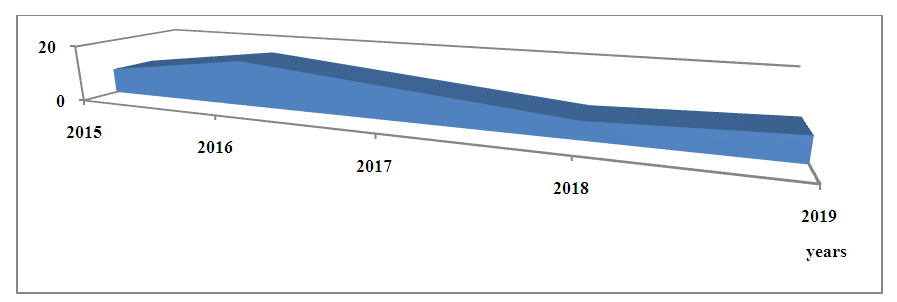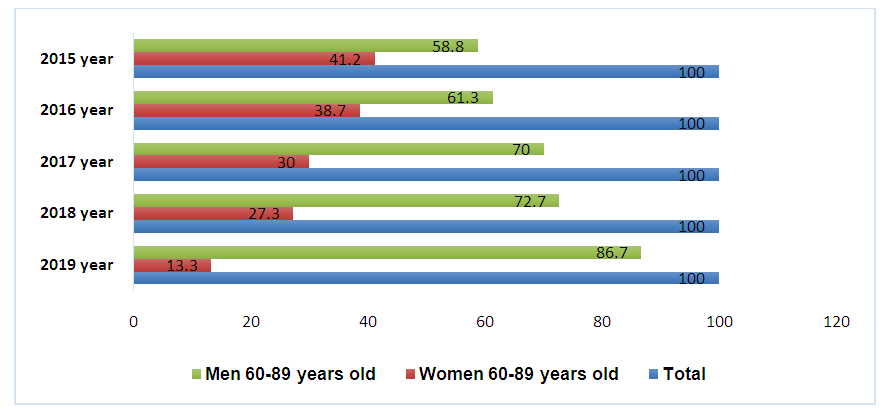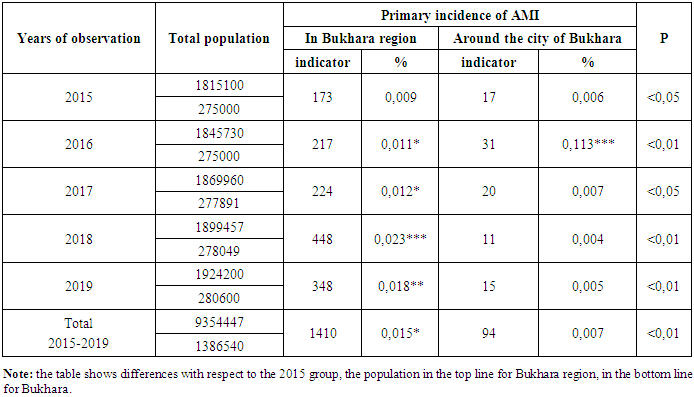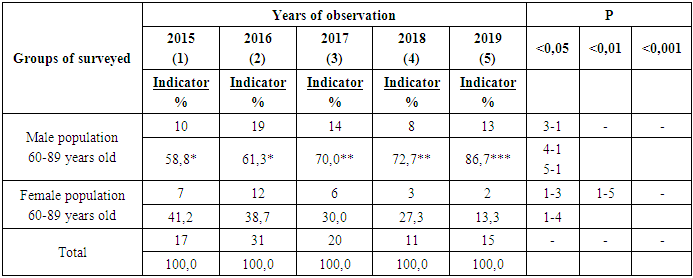-
Paper Information
- Next Paper
- Paper Submission
-
Journal Information
- About This Journal
- Editorial Board
- Current Issue
- Archive
- Author Guidelines
- Contact Us
American Journal of Medicine and Medical Sciences
p-ISSN: 2165-901X e-ISSN: 2165-9036
2022; 12(6): 673-676
doi:10.5923/j.ajmms.20221206.13
Received: May 6, 2022; Accepted: Jun. 3, 2022; Published: Jun. 23, 2022

Comparative Analysis of Incidence from Acute Myocardial Infarction among the Elderly and Old Population
Rakhmatova Dilbar Bahriddinovna
Department of Internal Diseases and Endocrinology, Bukhara State Medical Institute, Bukhara, Uzbekistan
Correspondence to: Rakhmatova Dilbar Bahriddinovna, Department of Internal Diseases and Endocrinology, Bukhara State Medical Institute, Bukhara, Uzbekistan.
| Email: |  |
Copyright © 2022 The Author(s). Published by Scientific & Academic Publishing.
This work is licensed under the Creative Commons Attribution International License (CC BY).
http://creativecommons.org/licenses/by/4.0/

Relevance. Myocardial infarction is one of the clinical forms of coronary heart disease, which occurs with ischemic necrosis of the myocardium. Myocardial infarction develops in patients aged 40 to 60 years and most often affects men, it is also the main cause of disability worldwide. The following sentence in the abstract can be summarized: from Myocardial infarction develops in patients aged 40 to 60 years and most often affects men, it is also the main cause of disability worldwide. Myocardial infarction is the most common disease, which is a common cause of death worldwide to, for example: Myocardial infarction develops in patients aged 40 to 60 years and most often affects men, it is also the main cause of disability worldwide, and a common cause of death.
Keywords: Epidemiology, Retrospective, Dynamics, Population, Diagnostics
Cite this paper: Rakhmatova Dilbar Bahriddinovna, Comparative Analysis of Incidence from Acute Myocardial Infarction among the Elderly and Old Population, American Journal of Medicine and Medical Sciences, Vol. 12 No. 6, 2022, pp. 673-676. doi: 10.5923/j.ajmms.20221206.13.
Article Outline
1. Relevance
- Myocardial infarction is one of the clinical forms of coronary heart disease, which occurs with ischemic necrosis of the myocardium. Myocardial infarction develops in patients aged 40 to 60 years and most often affects men, it is also the main cause of disability worldwide. Myocardial infarction is the most common disease, which is a common cause of death worldwide [1,9]. In Uzbekistan, the prevalence of this pathology is much more common, and is a socially significant disease, since many patients die from this nosology [1,2]. Scientists have determined that this pathology is most common in economically developed countries. One of the most common pathologies that is the cause of disability. According to WHO, men get sick more often than women [3]. The frequency of acute myocardial infarction according to statistics in men older than 40 years is from 2 to 6 per 1 thousand [4,5]. The urban population gets sick more often than residents in rural areas, but these data must also be taken into account with the possibility of diagnostics, which may not be carried out in rural areas [3,5,10].In our country, morbidity and mortality from myocardial infarction remain high. In fact, today the diagnosis of MI is based on a clinical assessment of the patient's condition, taking into account the anamnesis, ECG data and specific laboratory parameters. Early diagnosis of myocardial infarction is not a completely solved problem. Recurrent myocardial infarction is accompanied by many complications, more pronounced remodeling of the myocardium of the heart and high mortality. It should be borne in mind that due to the premature use of modern methods of treatment, the number of patients who survived after a primary MI is increasing, and the number of patients with recurrent MI is significantly increasing [6,7,8]. The healthcare system of our region suffers from the lack of interaction between hospitals and polyclinics in the timely admission of patients with myocardial infarction to the dispensary and the strict provision of their treatment.
2. Purpose of the Study
- To introduce a comparative analysis of the incidence of acute myocardial infarction among the elderly and senile population of the city of Bukhara (According to a retrospective analytical epidemiological study).
3. Materials and Research Methods
- Retrospective monitoring was carried out during 2015-2019 and annually information was collected on the primary incidence of AMI according to the statistics department of the Bukhara region of the State Committee of the Republic of Uzbekistan on statistics. Based on these data, all cases of primary morbidity were selected in a selected population of 60-89 years old in the Bukhara region and the city of Bukhara.
4. Research Results
- IHD accounts for 26.6% in the structure of the population's appeals for CVD, and 20.1% in the structure of morbidity among the adult population. The prevalence of coronary artery disease rises sharply with age - from 2-5% at the age of 45-54 years to 11-20% at the age of 65-74 years; lethality in coronary artery disease -3.02%, in myocardial infarction - 4.5% of the number of patients who left hospitals [1,2]. The epidemiology of the incidence of AMI in elderly and senile patients has been studied relatively insufficiently, especially in the regions of Uzbekistan. In this regard, the next goal of our study was a comparative analysis of the incidence of AMI among the elderly and senile population according to a 5-year retrospective analytical epidemiological study in the Bukhara region of Uzbekistan (Table 1).
|
|
 | Figure 1. Dynamics of the primary incidence of AMI in the elderly and senile population of the city of Bukhara for the period 2015-2019 (%) |
 | Figure 2. Dynamics of primary incidence of acute myocardial infarction depending on gender in 2015-2019 (in %) |
5. Findings
- It turns out that the population of elderly and senile age lives with insufficiently resolved problems before the nosological / early diagnosis and prevention of AMI, which are practically not discussed at the population level. As a result, this can lead to unfavorable epidemiological situations: on the example of Bukhara, according to our data, up to 74.1% in elderly and senile people (up to and 82.8% in men and up to 66.7% in women). It can be assumed that the experience of epidemiological screening will be useful in further regional preventive studies, will serve to unite the efforts of science and practice in the development of an urgent geriatric problem - the prevention of AMI/CVD in the elderly and senile.Information about the source of support in the form of grants, equipment, and drugs. The authors did not receive financial support from manufacturers of medicines and medical equipment.Conflicts of interest: The authors have no conflicts of interest.
 Abstract
Abstract Reference
Reference Full-Text PDF
Full-Text PDF Full-text HTML
Full-text HTML
